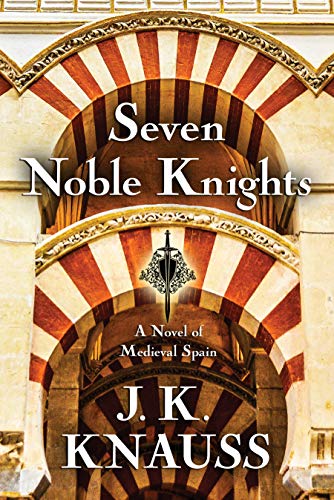Jessica Knauss’s novel, Seven Noble Knights, brings to life a story from an epic poem that doesn’t exist. The tale of the seven sons of the noble Lara family, killed in vengeance during the tumultuous tenth century, is known to us today first from Alfonso X’s thirteenth-century Estoria_de_España and the Chronicle of 1344. Scholars infer from these two late sources, an original epic poem, whether an indigenous creation or one inspired by the epic poetry of the French, and they debate whether it and other early stories that found their way into the chronicle tradition are wholly imagined or have a basis in historical fact. I have myself written about a different tale from that period found only in later histories, that of Bernardo del Carpio, and I argued that story did have a basis in history, so I was eager to read Knauss’s version of this powerful story.
At first I was thrown off, because I was expecting a historicized version that takes the tale out of its later written form and situates it into the grim tenth century. What Knauss has done instead is to write the lost epic poem into the visual and material world of the thirteenth/fourteenth-century of its sources for it, much like, for instance, T.H. White did with the Arthurian tales in The Once and Future King, which placed later stories about a maybe-fifth-century king in a sort-of late medieval England of the imagination, a kind of no-time no-place. Once I realized what she was doing (and truly, only the five or six of us in the world who have spent too much time thinking about tenth-century Spain would be thrown off in this way), I settled down to enjoy the wild ride Knauss takes us on.
What I liked most about this book, is how true Knauss is to the spirit of her materials, and how uncompromising she is to the values of their time. Seven Noble Knights has the feeling of the epic poem it imagines. This is a world of blood and sex, of vengeance carried out personally by hand. These people are alien to us, what they care about, what makes them angry and how they deal with it, and Knauss allows them to retain this strangeness. Her use of language and her imagery emphasizes this sense of distance. These are not the characters of usual twenty-first century historical fiction, whom we imagine as “three-dimensional” because of their fictive interiority. Knauss’s characters are figures in the way that the characters of medieval literature are figures. We often call (or dismiss) them as stereotypes but I think Knauss’s book shows how powerful this kind of writing can be.
I felt this especially vividly with the character of Doña Lambra, who is the pivot point around whom so much of the action turns. While the centrality of the women to this story might surprise modern readers, it shouldn’t. Mercedes Vaquero, who has written brilliantly about this story and others like it, has argued that one of their roles was to create a space to discuss the fraught question of noble lineage, and women’s roles in creating and perpetuating it, and that women themselves may have been the patrons for these stories. I kept thinking of Vaquero as I was reading, and when I got to the end, lo, I discovered that Knauss had been her PhD student.
I think this novel will appeal to readers searching out a different kind of historical novel than most of what is published right now, a novel that doesn’t “bring you back in time,” but rather immerses you in a strange world and an unusual-to-us kind of story-telling.

